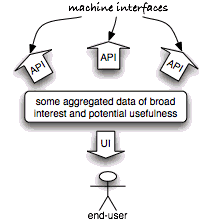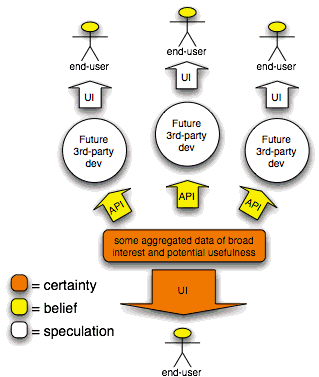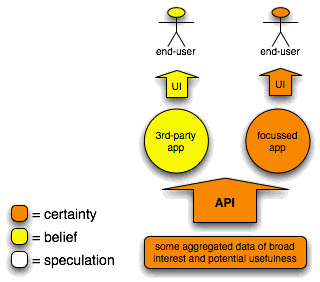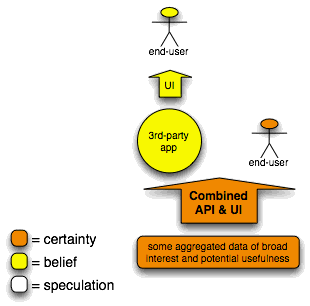An infrastructure service anti-pattern
Last week I outlined an idea, that of the service anti-pattern, as part of a presentation I gave to the Resource Discovery Taskforce (organised by JISC in partnership with RLUK). The idea seemed to really catch the interest of and resonate with several of those members of the taskforce who were present at the meeting. My presentation was in a style which does not translate well to being viewed in a standalone context (e.g. on Slideshare) so I have decided to write it up here. I would very much welcome comments on this. (The presentation will be published on the Resource Discovery Taskforce pages and I will ask for this post to be linked to from there when it does appear).
The following diagram is meant to represent a design 'pattern' which I have seen often proposed, and sometimes implemented, in the JISC Information Environment (IE) as well as in the wider higher education (HE) sector in general:

It is my belief that readers who have been involved with the IE for some time will recognise this, at least in a general sense, if not in specific cases. In this arrangement, an aggregation of data is presented to the end user, through the development of a user-facing application or service. The user-facing service will in almost all cases be a web-interface, somewhat similar to the ‘portal’ concept of old but in a centralised, single, global deployment. Because it is generally accepted to be desirable to make such data available to other services (in keeping with the larger goal of interoperability through open standards), one or more machine interfaces or so-called APIs, giving access to the 'backend' of the system, will be offered. What this design pattern aspires to is a service implemented to be both user-facing service and machine-facing infrastructure component.
However, I contend that this is, in fact, what software engineers might call an anti-pattern. An anti-pattern is a design approach which seems plausible and attractive but which has been shown, with practice to be non-optimal or even counter-productive. It's a pattern because it keeps coming up, which means it's worth recording and documenting as such. It's anti, because, in practice, it's best avoided….
There is much which is implicit in this pattern, so I will attempt to surface what I believe are some hidden assumptions in a new version of this diagram: this is what this design pattern, once implemented, reveals:

In this second diagram, the orange colouring indicates the parts which actually get built and are supported; the yellow indicates the parts which might get built, but which won't really be supported as a service - in a sense, this is stuff which is believed to work but actually doesn't; in the case of the users, the yellow colouring indicates that their demand for this service is believed to exist; those components in the diagram which are neither orange, nor yellow, are the product of little more than speculation. In the end, the investment in creating a user-facing application based on an expectation of future demand which doesn't materialise is wasted while, at the same time, the investment in providing unused machine interfaces is also wasted.
I believe that this design pattern rests on several assumptions which are actually fallacies, and is, therefore, an anti-pattern.
Fallacy 1: “Build it and they will come”:
While infrastructure services can, indeed should, be developed with future opportunity in mind, it is helpful to have an existing and real demand to satisfy, which the new development addresses. If the service is demonstrably useful to users, and is developed effectively with future opportunity in mind, then there is more chance of the service actually working, and of it being attractive to developers working on future opportunities.
Fallacy 2: Interoperability through additional machine interfaces:
Machine interfaces need as much specification, development, testing an maintenance as user-interfaces. Simply making a machine interface available through the adoption of a platform which has a built-in facility offering some standard interface is not enough. A system which proposes to offer three or four APIs is quite likely not going to support any of them adequately. I have argued before that ' interoperability is not enough': in fact, this arrangement does not often lead to interoperability, let alone actual exploitation of the capability to interoperate.
Fallacy 3: People/organisations who can make good infrastructure are also going to be good at building end-user-facing services (and vice versa):
Effective infrastructure supports services which in turn support end-users. The skills and knowledge required to support service-providers are generally quite different from those needed to deliver good user-facing services.
I call this the infrastructure service anti-pattern because the result comes from conflated requirements to deliver both infrastructure (machine-to-machine interfaces) and compelling user-facing services and applications. The result can be something which satisfies neither requirement. The users, requirements and priorities are often completely different between these two problem spaces. I suggest that the following are some possible reasons for this anti-pattern appearing:
- funding (naturally) tends to follow services, happy users and, importantly, new features.
- funders like to see their investment showcased
- infrastructure is mostly invisible making it hard to ascertain impact from users
Proposals for alternative design patterns
Here is a suggested alternative design-pattern:

In this design pattern, the API is developed before any user-facing application, or at least in parallel. An application is developed to exploit this API based on real users requirements. No service is developed until such requirements can be identified. This means that an API will be developed, and it will be being used in at least one case. Opportunities for third party integration for usage of the service are, ideally, identified beforehand. The API is properly supported from the start, or else the service fails completely. The value proposition being offered for further, opportunistic third-party developments, whether real or imagined, is now real and, crucially, supported.
An interesting alternative to this is the approach of combining the user-facing web pages and the machine-actionable API into one interface, through embedded RDFa for example:

It remains to be seen how this approach is going to work out over time, but we have seen hints of simpler approaches to combining user and machine interfaces in the past, such as RSS being styled to give a decent human-readable interface, or earlier attempts to do interesting things with XHTML.
I wonder if readers agree that the first diagrams represent an anti-pattern which they recognise. And would the proposed alternatives fare any better?